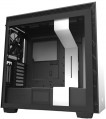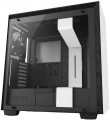Form factor
The form factor determines, first of all, the internal volume of the case (as a result, the motherboard used for it, see "Type of motherboard"), as well as installation features. To date, PC cases are available in the following main form factors:
—
Full Tower. The tower case is one of the largest form factors for PCs today: 15-20 cm wide, 50-60 cm high, with up to 10 externally accessible bays. Most often in this form factor running advanced high performance PCs.
—
Ultra Tower. Further development and expansion of Full Tower cases (see above), offering even more space for hardware: the width of such a case is about 25 cm, the height can reach 70 cm, which allows you to install powerful configurations inside and provides enough free space for effective cooling .
—
Midi Tower. A representative of the tower family (tower cases) of medium size — about 45 cm in height with a width of 15-20 cm, with the number of external bays from 2 to 4. Most popular for middle-class home PCs.
—
Mini Tower. The most compact "vertical" case type, with a width of 15-20 cm, has a height of about 35 cm and (usually) less than 2 compartments with external access. It is mainly used for assembling office PCs that do not require high performance.
—
Desktop. Enclosures designed for i
...nstallation directly on the desktop. They often have the possibility of horizontal installation — in such a way that a monitor can be placed on top of the case — although there are also models that are installed strictly vertically. The size of such cases can be almost anything — from miniature solutions for thin mini ITX motherboards to large-sized cases for E-ATX (see "Motherboard type"). However, most "desktops" are relatively small.
— Cube Case. Cases having a cubic or close to it shape. They can have different sizes and are intended for different types of motherboards, this point in each case should be clarified separately. Anyway, such cases have a rather original appearance, different from traditional "towers" and "desktops".
— Dual Tower. Quite a rare option — cases, in size and proportions resembling two "towers", made up side by side. Dual Tower solutions are large in size and are intended mainly for powerful high-performance PCs (in particular, top gaming stations).
Note that there are models that allow both vertical and horizontal installation and can, in fact, turn from a "tower" to a "desktop" and vice versa. For such cases, the form factor is indicated by the form factor named in the manufacturer's documentation, or by the main installation method described there.Expansion slots
The number of slots for expansion cards located on the rear panel of the case.
The expansion card itself (graphics card, sound card, TV tuner, etc.) is installed in a slot on the motherboard, and an external panel of such a card with inputs and outputs is attached to the hole on the back of the case. The more holes are provided in the case, the more expansion cards can be installed in it. Note that some boards can occupy two or even three holes at once; this is especially common in powerful video cards. On the other hand, you have to pay attention to the number of holes mainly if you are building a powerful high-performance system. For an ordinary household PC, in most cases, one opening is enough for a graphics card; and in many configurations, the openings on the rear panel are not used at all.
Graphics card vertical mount
The ability to install a graphics card in the case vertically, facing the side panel. To do this, the design provides for an appropriate bracket, and the graphics card is connected to the motherboard with a special extension cable — a riser. This feature is found in open cases and models with a viewing window (see relevant paragraphs), its purpose is primarily aesthetic: a vertically placed graphics card is clearly visible from the outside, which gives the case an original appearance, designed for fans of external modding. But
vertical installation does not provide any fundamental practical advantages.
Liquid cooling support
This feature is indicated for housings that normally allow the installation
of liquid cooling systems(LCS). Such systems are extremely efficient, but complex and expensive, so they are mainly used in high-performance PCs, for which traditional coolers are no longer enough. Note that theoretically, liquid cooling can be installed in almost any case; however, if support for such cooling is not initially provided in the design, this can be very difficult. So if you initially plan to use LSS, you should choose a case for which support for this function is directly claimed.
Liquid cooling (rear)
The size of the seat for the water cooling system provided on the back of the case.
In cases with CBO support, water cooling radiators are installed in the same slots as traditional fans. In other words, either a fan (fans) or a CBO radiator can be installed on the same seat. The size of the seat under the CBO is indicated by one number — the length (on the larger side); the width can be determined based on these data. The fact is that modern CBO radiators usually use fans of one of the standard sizes — 120 mm or 140 mm; and if there are several such fans, they are arranged in a row. As a result, the length of the radiator turns out to be a multiple, and the width is equal to one of these numbers: for example, 280 mm is 2x140 mm with a width of 140 mm, and 360 mm is 3x120 mm with a width of 120 mm.
Note that in this case, the same nuances are relevant as for air cooling: a larger fan takes up more space and costs more, but it is considered more advanced, as it can work efficiently at a lower speed — and this reduces the level of noise and vibration.
Liquid cooling (front)
The size of the seat for the water cooling system provided on the front side of the case.
In cases with CBO support, water cooling radiators are installed in the same slots as traditional fans. In other words, either a fan (fans) or a CBO radiator can be installed on the same seat. The size of the seat under the CBO is indicated by one number — the length (on the larger side); the width can be determined based on these data. The fact is that modern CBO radiators usually use fans of one of the standard sizes — 120 mm or 140 mm; and if there are several such fans, they are arranged in a row. As a result, the length of the radiator turns out to be a multiple, and the width is equal to one of these numbers: for example,
280 mm is 2x140 mm with a width of 140 mm, and 360 mm is 3x120 mm with a width of 120 mm. In general, the size of the front radiator of
240 mm or less is considered relatively small, 280 mm — medium,
360 mm — large, and in some models it reaches
420 mm or even more.
Note that in this case, the same nuances are relevant as for air cooling: a larger fan takes up more space and costs more, but it is considered more advanced, as it can work efficiently at a lower speed — and this reduces the level of noise and vibration.
Liquid cooling (top)
The size of the seat for the water cooling system provided on the top side of the case.
In cases with CBO support, water cooling radiators are installed in the same slots as traditional fans. In other words, either a fan (fans) or a CBO radiator can be installed on the same seat. The size of the seat under the CBO is indicated by one number — the length (on the larger side); the width can be determined based on these data. The fact is that modern CBO radiators usually use fans of one of the standard sizes — 120 mm or 140 mm; and if there are several such fans, they are arranged in a row. As a result, the length of the radiator turns out to be a multiple, and the width is equal to one of these numbers: for example,
280 mm is 2x140 mm with a width of 140 mm, and 360 mm is 3x120 mm with a width of 120 mm. In general, the size of the upper radiator of
240 mm or less is considered relatively small, 280 mm — medium,
360 mm — large, and in some models it reaches
420 mm or even more.
Note that in this case, the same nuances are relevant as for air cooling: a larger fan takes up more space and costs more, but it is considered more advanced, as it can work efficiently at a lower speed — and this reduces the level of noise and vibration.
Liquid cooling mounts
The total number of places for water cooling systems provided in the case, in other words, the largest number of CBO radiators that can be installed in the case. Such radiators are usually placed one at a time on the side of the case, so several radiators are most often located on different sides: for example, 3 places for CBO can be located at the back, top and front.
When estimating the number of seats (of all types), it should be taken into account that CBO fans and radiators usually use the same seats.
USB 2.0
The number of native
USB 2.0 connectors provided in the case.
Such connectors are usually located on the front side (for more details, see "Location"). They are most convenient for peripherals that need to be connected and disconnected often — for example, "flash drives" (for permanently connected devices, it is more convenient to use the motherboard connectors displayed on the rear panel). Specifically, USB 2.0 is now considered obsolete: it provides a data transfer rate of only 480 Mbps and a relatively low power supply. However, in many cases this is enough, and USB 2.0 ports continue to be used, including in fairly advanced cases.

